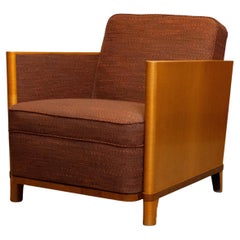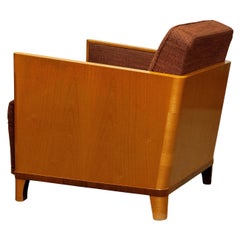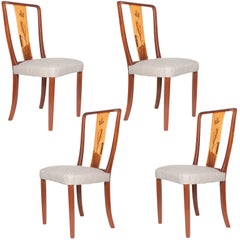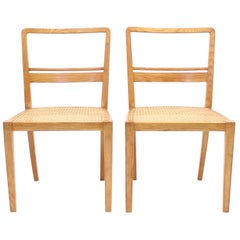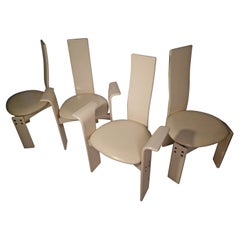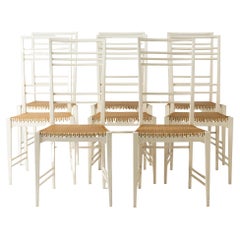Chamberts Möbelfabrik Furniture
5
to
4
1
5
5
5
3
2
5
5
4
5
4
3
3
3
5
5
4
3
5,206
4,014
2,455
2,235
Creator: Chamberts Möbelfabrik
Matching Pair Art Deco Chairs with Elm Base and Dark Brown Wool by Erik Chambert
Located in Silvolde, Gelderland
Beautiful and rare matching set of two Art Deco club / lounge chairs with elm veneered frame upholstered with original dark brown melle fabric which is still in very good and comfort...
Category
1930s Swedish Art Deco Vintage Chamberts Möbelfabrik Furniture
Materials
Wool, Elm, Pine
1930's Swedish Art Deco Chair with Elm Base and Dark Brown Wool by Erik Chambert
Located in Silvolde, Gelderland
Beautiful and rare Art Deco club / lounge chair with elm veneered frame upholstered with original dark brown melle fabric which is still in very good and comfortable condition. Also ...
Category
1930s Swedish Art Deco Vintage Chamberts Möbelfabrik Furniture
Materials
Wool, Elm, Pine
1930's Swedish Art Deco Chair with Elm Base and Dark Brown Wool by Erik Chambert
Located in Silvolde, Gelderland
Beautiful and rare Art Deco club / lounge chair with elm veneered frame upholstered with original dark brown melle fabric which is still in very good and comfortable condition. Also ...
Category
1930s Swedish Art Deco Vintage Chamberts Möbelfabrik Furniture
Materials
Wool, Elm, Pine
Scandinavian Modern Erik Chambert Set of Four Dining Chairs
Located in New York, NY
Scandinavian Modern group of four solid mahogany dining chairs with back panels veneered in walnut, elm root, rosewood and birch marquetry, Designed by Erik Chambert, made at Chamber...
Category
Mid-20th Century Scandinavian Scandinavian Modern Chamberts Möbelfabrik Furniture
Materials
Wood
Erik Chambert, Very Rare Pair of Chairs, AB Chamberts Möbelfabrik, 1937
Located in Uppsala, SE
Very rare pair of chairs designed by Erik Chambert in 1937 and produced by his own company AB Chamberts Möbelfabrik. Frame made of ash with cane seat. This exact model was displayed ...
Category
1930s Swedish Scandinavian Modern Vintage Chamberts Möbelfabrik Furniture
Materials
Cane, Ash
Related Items
Set of 4 Erik Kirkegaard Teak Mid-Century Side Chairs
By Erik Kirkegaard
Located in New York, NY
Set of 4 midcentury Danish black vinyl and teak side chairs. Glostrup Mobelfabrik (Maker), Erik Kirkegaard (Designer).
Category
Mid-20th Century Danish Mid-Century Modern Chamberts Möbelfabrik Furniture
Materials
Faux Leather, Wood, Teak
Post Modern Italian Lacquered Set of Four Dining Chairs
By Saporiti
Located in Port Jervis, NY
Set of 4 Postmodern lacquered white dining room chairs. Marked made in Italy, in the style of Saporiti. Minor blemishes to the lacquer is at a...
Category
1980s Italian Post-Modern Vintage Chamberts Möbelfabrik Furniture
Materials
Naugahyde, Hardwood
Rare Pair of Black Lacquer Chairs J.C. Mahey, 1970s
By Jean Claude Mahey, Maison Romeo
Located in Paris, IDF
Sleek, stately lines, Asian inspired with a bold twist like seen in this pair of chairs, were the marks of the French designer Jean-Claude Mahey. These rare pieces were designed by M...
Category
1970s French Mid-Century Modern Vintage Chamberts Möbelfabrik Furniture
Materials
Wood
Radiant Pair of Art Deco Revival Club Chairs in Magnificent French Cane
Located in Atlanta, GA
An exquisite restored pair of rattan Art Deco Revival club chairs, circa 1980. Fabulous rattan frame construction completely veneered in heavy French Cane. Design, quality and crafts...
Category
1980s Unknown Art Deco Vintage Chamberts Möbelfabrik Furniture
Materials
Cane, Rattan
Set of 4 Vintage Scandinavian Midcentury Modern Teak Wood & Fabric Dining Chairs
By Glostrup Møbelfabrik
Located in Warszawa, Mazowieckie
This set of four modernist chairs was manufactured by the Danish manufacturer Glostrup Møbelfabrik during the 1960s. They are made of solid teak in a warm shade of brown. The seat is...
Category
1960s Danish Scandinavian Modern Vintage Chamberts Möbelfabrik Furniture
Materials
Fabric, Teak
H 31.89 in W 19.3 in D 16.93 in
Italian Art Deco Pair of Lounge Chairs in Burgundy Velvet
Located in Waalwijk, NL
Pair of lounge chairs, velvet upholstery, lacquered wood, Italy, 1940s.
This exquisite pair of lounge chairs of Italian origin undoubtedly breathes the late Art Deco Period of the ...
Category
1940s Italian Art Deco Vintage Chamberts Möbelfabrik Furniture
Materials
Velvet, Wood
Rare Pair of Stamped Maison Jansen Louis XV Neoclassical Chairs, 1940s
By Maison Jansen
Located in Paris, IDF
The construction of this pair of chairs was deeply cared about, and it shows in the finished product, even some eight decades later. The chairs were made and stamped by French firm M...
Category
1940s French Louis XV Vintage Chamberts Möbelfabrik Furniture
Materials
Velvet, Oak
H 35.44 in W 20.08 in D 20.87 in
Art Deco Club Chair in Black Motorcycle Leather
Located in New York, NY
An oversized club chair with a strong masculine frame, crafted of solid and bent birch and upholstered in tough, black motorcycle leather.
Category
1930s Swedish Art Deco Vintage Chamberts Möbelfabrik Furniture
Materials
Leather, Birch
Rare Pair of Philippe Starck Chairs from the Royalton Hotel, NYC
By Philippe Starck
Located in Los Angeles, CA
Rare pair of Philippe Starck chairs from the Royalton Hotel, NYC. Original label. Royalton Hotel is located just east of...
Category
1980s North American Post-Modern Vintage Chamberts Möbelfabrik Furniture
Materials
Mahogany, Plywood
Karl Erik Ekselius for JOC Dining Desk Side Chair
By Karl-Erik Ekselius, JOC Mobler Vetlanda
Located in New York, NY
Midcentury Danish modern style side chair, made in Sweden for JOC, designed by Karl Erik Ekselius. The chair has a leather seat, and backrest, on a solid wood (probably dark stain te...
Category
Mid-20th Century Swedish Scandinavian Modern Chamberts Möbelfabrik Furniture
Materials
Leather, Teak
French Pair of Art Deco Lounge Chairs in Beige Upholstery
Located in Waalwijk, NL
Pair of lounge chairs, fabric and oak, France, 1940s.
Wide and comfortable chairs in a soft beige velours upholstery. Truly extraordinary lounge chairs that feature a very deep seat...
Category
1940s French Art Deco Vintage Chamberts Möbelfabrik Furniture
Materials
Fabric, Oak
Pair of Brutalist Chairs
By Pierre Chapo
Located in Brooklyn, NY
Very nice sculpted rustic chairs in plain wood. Close to the work of Chapo.
Category
Mid-20th Century French Brutalist Chamberts Möbelfabrik Furniture
Materials
Elm
Previously Available Items
Set of Eight "Poem" Dining Chairs by Erik Chambert, Sweden, 1950s
Located in Stockholm, SE
Set of eight “Poem” dining chairs by Erik Chambert, made from white lacquered wood with rattan seats.
The model was first presented in...
Category
1950s Swedish Scandinavian Modern Vintage Chamberts Möbelfabrik Furniture
Materials
Rattan, Wood
Erik Chambert Walnut Mirror, Swedish Modern, 1930s
Located in Skanninge, SE
Unusual mirror by Erik Chambert for Chamberts Möbelfabrik in Norrköping.
Really good quality and perfect condition.
Erik Chambert (1902-1988) was one of the first interior designers to graduate from Högre Konstindustriella Skolan (now the University College of Arts, Crafts, and Design, Konstfack) in 1925. Before that, he had been awarded a silver medal for his apprentice piece in cabinet-making. He and his brother, the master cabinet-maker Otto, ran the family furniture-making business AB Chamberts Möbelfabrik in Norrköping, with Erik as the artistic director. The company had been founded in 1883 by their father, Axel Chambert.
As an interior designer, Erik Chambert’s first major assignment was for the Stockholm Exhibition in 1930, where he designed the functionalist interior for an apartment by the recently-appointed municipal architect of Norrköping, Kurt von Schmalensee. Gotthard Johansson expressed his opinion on Chambert’s participation in the daily paper Svenska Dagbladet: “where simplicity has not become indigent, nor functionalism dogmatic”. The senior curator for the Stockholm Exhibition, Gregor Paulsson, commented on the apartment in an appreciative letter to Erik Chambert: “As for my personal opinion, I would like to say unconditionally that I consider it to be the biggest success of the entire exhibition. It is in keeping with the spirit we wished to achieve.”
Erik Chambert designed practical, comfortable and timeless furniture in a functionalist style that gave a blond, sober impression. Helena Dahlbäck Lutteman has called the style “humane functionalism”. Study trips around Europe after his graduation acquainted Erik Chambert with the Bauhaus school and Art Concrete. He was influenced by contemporary trends but reformulated what he saw and experienced in his style. For the Stockholm Exhibition, he designed a folding recliner with light wood construction and red varnished armrests in steel. This was the only time he used this particular material that was fashionable during that period. Källemo AB in Värnamo began making replicas of the recliner and other classics by Erik Chambert in recent decades. One of these new recliners is currently standing in the library of Arkitektur- och designcentrum (earlier Arkitekturmuseet) in Stockholm. Erik Chambert believed that a piece of furniture should be functional and blend with the surroundings. A work desk with a reversible pine top, one side for work and the other for more festive occasions, with a shelf construction of wood slats underneath for paper and drawings, was shown at an exhibition in Zurich in 1949. Usually, his designs were only produced in one or very few copies. The chair “Poem” from 1953 is a rare exception.
The year before he died, Erik Chambert said, “Exhibitions have been my life.” As a furniture designer, he participated in numerous prestigious international exhibitions together with AB Chamberts Möbelfabrik: Chicago in 1933, the world fairs in Brussels and Paris in 1935 and 1937 respectively, the international crafts exhibition in Berlin in 1938 and the world exhibition in New York in 1939.
Erik Chambert gave vent to his visual creativity when he designed furniture. This is evident, for instance, in the rich marquetry he made to order or for exhibitions. He took a delight in creating entire pictures, not just patterns, in marquetry, depicting figures or cityscapes in different woods. He often combined these with shimmering mother of pearl and metals. In 1945, he designed the cabinet “The Scales of Life”, now in the Nationalmuseum collection. The marquetry inlayer was Manne Manning. The cabinet was based on an eponymously titled gouache from 1943.
As an interior designer, Erik Chambert was frequently commissioned for public spaces and private homes. Most assignments were from institutions and private companies in and around Norrköping, but his clients also included Haga Palace and the Tessin Palace, through the National Board of Public Buildings. In addition to suggesting furniture and textiles, he was involved in deciding the color schemes for walls, designing fabrics, sometimes for specific purposes, composing tapestries and a few larger curtains with appliqué work. In the book “Svenska Textilier 1890-1990” (Swedish Textiles 1890-1990), Anne-Marie Ericsson writes, “An interesting example is the furniture designer Erik Chambert, who allowed both his disciplines, as an artist and a designer, to merge in his rhythmically distinct patterns for textile prints.” Erik Chambert collaborated with Jobs Handtryck and Tabergs Yllefabrik, among others. A textile with stylized Norrköping scenes for the foyer walls of the municipal theatre in Norrköping and also the textile ”Skyttlarna” was recently revived and put into production by Stadsmuseet in Norrköping. The museum also has the Chambert company’s archives in its collection.
In the 1920s and 1930s, Erik Chambert made many exquisite watercolored sketches of furniture set in their imagined context in the furnishing of a room. As studies for cabinet embellishments, wall paintings, and wallpaper he painted grass and flowers. Towards the end of the 1930s, the gouaches developed and began to feature figurative elements and organic non-figurative billowing forms. In 1943, Erik Chambert made his debut at the Liljevalchs autumn exhibition. He was subsequently represented in several exhibitions at Liljevalchs. In the 1950s, Erik Chambert painted abstracts which he initially called Compositions, followed by a number of capital letters. Bo Sylvan writes that Erik Chambert’s paintings tended towards “geometrically pruned shapes and a fastidious palette”. Up until 1959, Erik Chambert painted in gouache, but in 1960 he went over to oils.
In the mid-1960s, Erik Chambert abandoned his flat compositions and began creating reliefs in white, black or red paper or silver paper and gold foil, in a striving to achieve tension with a spatial effect. The viewer was encouraged to move in front of the work to perceive how light and shade enhanced the impression. The reliefs were built into boxes of Plexiglas, which were part of the work of art. “Lady with Dog” is an early example of this technique. The work was produced in 100 identical copies. It was included in the art society Konstfrämjandet’s exhibition “Multikonst” (Multi-Art) which was shown at 100 venues throughout Sweden simultaneously in 1967.
Erik Chambert has been regarded as a Concretist but, as Staffan Carlén points out in the foreword to the catalog to the solo exhibition at Millesgården in 1990, “Erik Chambert did not want to label his works as Concrete, and it would therefore perhaps be more Apt to speak of geometric abstraction.” His works were nearly always based on an experience or impression, such as thoughts on life, as in “The Scales of Life”, the triptych “Life Cycle” from 1963, now in Norrköpings konstmuseum, or series I-X from “A Life” or other pictures from the same, often made in connection with annual summer trips to European destinations, for instance “Les Halles” (1965), “Pointe du Raz” (1967) or “Gibraltar” (1980).
In the late 1960s, throughout the 1970s and in the early 1980s, Erik Chambert pursued his exploration of light and refraction, using only Plexiglas sheets and rods, occasionally with additions of paint to enhance the motif. In his speech at the opening of the exhibition at Millesgården, Bo Sylvan called the crystal-clear Plexiglas relief sculptures from the early 1980s “light organs”. All the Plexiglas works with their accompanying boxes were sawn, honed and joined by hand with aesthetic ingenuity. As a young cabinetmaker’s apprentice, he had learned to handle wood with great skill. Likewise, the mature artist used his inventiveness and craftsmanship to find technical solutions when working with Plexiglas. All the boxes are square, the largest measuring 1×1 meter. Erik Chambert enjoyed the Challenge of achieving expansive tensions in a square.
Otto G. Carlsund and Gösta Adrian Nilsson...
Category
1930s Swedish Scandinavian Modern Vintage Chamberts Möbelfabrik Furniture
Materials
Glass, Walnut
Early Swedish 'Grace' Chaise Longue in Deep Red
Located in Waalwijk, NL
Daybed presumably by Chambert's Möbelfabrik red upholstery, oak, brass, Sweden, 1930s.
This freestanding daybed goes with the title “Swedish Grace” and features a dark polished oa...
Category
1930s Swedish Scandinavian Modern Vintage Chamberts Möbelfabrik Furniture
Materials
Brass
Pair of Swedish Art Deco Modernist Lounge Chairs by Erik Chambert
Located in New York, NY
Pair of Swedish Art Deco modernist lounge chairs in stained solid birch. The chair's seat cantilever in the back and may be adjusted by releasing a discreet mechanism under the left ...
Category
1930s Swedish Vintage Chamberts Möbelfabrik Furniture
Elegant Swedish Art Deco Day Bed by Erik Chambert
Located in New York, NY
An elegant Swedish art deco daybed with birch and rosewood veneer and neoclassical inspired marquetry. Designed by Erik Chambert, Norrkoping circa late 1920's early 1930's. Restored ...
Category
Early 20th Century Swedish Art Deco Chamberts Möbelfabrik Furniture
Materials
Rosewood, Birch
Erik Chambert Swedish Art Deco Walnut Veneered Drop Front Secretary Cabinet
Located in New York, NY
Erik Chambert Swedish art deco drop front secretary cabinet. The pyramid shaped cabinet is decorated with panels and carvings and veneere...
Category
20th Century Swedish Art Deco Chamberts Möbelfabrik Furniture
Materials
Mirror, Wood, Walnut
H 42 in W 40 in D 18.25 in
Chamberts Möbelfabrik furniture for sale on 1stDibs.
Chamberts Möbelfabrik furniture are available for sale on 1stDibs. These distinctive items are frequently made of wood and are designed with extraordinary care. There are many options to choose from in our collection of Chamberts Möbelfabrik furniture, although brown editions of this piece are particularly popular. Many of the original furniture by Chamberts Möbelfabrik were created in the Art Deco style in scandinavia during the mid-20th century. If you’re looking for additional options, many customers also consider furniture by Gillis Lundgren, Ljungs Industrier Sweden, and Eric Sigfrid Persson. Prices for Chamberts Möbelfabrik furniture can differ depending upon size, time period and other attributes — on 1stDibs, these items begin at $3,737 and can go as high as $7,779, while a piece like these, on average, fetch $3,899.

